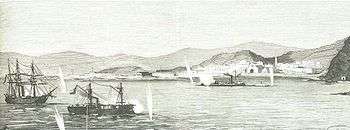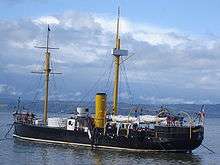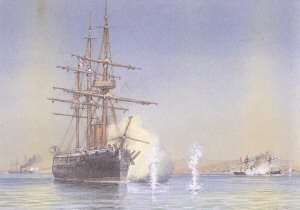Huáscar (ironclad)
 Huáscar in Peruvian service before her foremast was removed in June 1879 | |
| History | |
|---|---|
| Name: | Huáscar |
| Ordered: | 4 August 1864 |
| Builder: | Laird Brothers, Birkenhead, England |
| Launched: | 6 October 1865 |
| Commissioned: | 8 November 1866 |
| Captured: | Captured by Chile at the Battle of Angamos, 8 October 1879 |
| Acquired: | 8 October 1879 |
| Decommissioned: | 1897 |
| Reinstated: | 1934 |
| Status: | Museum ship |
| General characteristics | |
| Type: | Ironclad turret ship |
| Displacement: | 1,870 long tons (1,900 t) |
| Length: | 66.9 m (219 ft) |
| Beam: | 10.9 m (35.8 ft) |
| Draught: | 5.7 m (18.7 ft) |
| Installed power: | |
| Propulsion: | 1 × screw; 1 × Horizontal-return connecting rod-steam engine |
| Sail plan: | Brig-rigged |
| Speed: | 12 knots (22 km/h; 14 mph) |
| Complement: | 170 |
| Armament: |
|
| Armour: |
|
Huáscar is an ironclad turret ship built in Britain for Peru in the 1860s. Her price was a bit more than £81,000 pounds sterling. She was the flagship of the Peruvian Navy and participated in the Battle of Pacocha and the War of the Pacific of 1879–1883 before being captured and commissioned into the Chilean Navy. Today she is one of the few surviving ships of her type. The ship has been restored and is currently commissioned as a memorial ship. She is named after the 16th-century Inca emperor, Huáscar.[1]
Technical Details
Captain Cowper Coles, about his masterpiece, the Huáscar, wrote:
...as a sea-going vessel of 1,100 tons, 300-horse power, and a speed of 12 1/4 knots. Her foremast is fitted with tripods; she carries two 300-pounders in one turret.[2]
...the "Huascar" class of 1865 fitted with a hurricane deck; she was one of six different classes designed and built by Messrs. Laird Brothers, to whom the credit for their great success is due. She can fire right ahead from her 300-pounders, and aft within 15 degrees of the line of keel, but would have a stern chaser either on or under her poop.[3]
The British magazine Engineering, July 4, 1879, page 11, on the Peruvian ironclad turret ship Huascar writes:
She is an armour-clad monitor built by Messrs. Laird Brothers, of Birkenhead, in 1866...... She is 190 ft. in length between perpendiculars, 35 ft. in extreme breadth, and 19 ft. 9 in. in depth of hold. Her builder's tonnage is 1101, and indicated horse power 1500. Her draught of water is 15 ft. 6 in., and her maximum speed is said to be 12 knots when her boilers are in good condition, and the bottom is clean. Her usual speed under good working conditions is probably not more than 10 1/2 to 11 knots. She is propelled by a single screw. The Huascar is a rigged two-masted vessel, the foremast being upon Captain Cole's tripod principle. Her freeboard, or height of deck above water, is about 5 ft. She carries two 300-pounder Armstrong guns in one turret, which is protected by 5 1/2-in. armour plating upon a teak backing of 14 in. The sides are protected by armour plating 4 1/2 in. thick amidships, tapering to 2 1/2 in. at the extremities, which is also worked upon a teak backing of 14 in. There is an armoured pilot tower of hexagonal form abaft the turret from which the ship is worked in action; and the openings in the deck are protected by 2-in. iron plates that are shipped in the openings for skylights or hatchways. The Huascar is an iron-built vessel, and at the time she was built was most perfect in all the appliances of defence, and in her internal arrangements.
Historical details
Career (Peru)
Her first years

Huáscar was ordered by the government of Peru from John Laird Sons & Company in 1864 for the war against Spain. Laird House had extensive experience of these advanced ships, designing and building the Laird Rams. She was launched in Birkenhead on 7 October 1865.
Commanded by Chilean Captain José María Salcedo, Naval Officer in Peruvian Government's service, who had supervised construction on behalf of the Peruvian Navy, she left for Peru on 20 January 1866 on a trip that saw some trouble: a month-long wait at Brest, a minor collision with the ironclad Independencia on 28 February, refusal of service by neutral countries, a month of repairs at Rio de Janeiro, insubordination by Independencia's commander and the capture and sinking of the Spanish brigantine Manuel. When she finally arrived in port at Ancud in allied Chile to join the rest of the combined fleet on 7 June, it was too late for her to participate in the conflict.
Under Captain Lizardo Montero, Huáscar prepared at Valparaíso to participate in a late 1866 expedition to fight the Spanish fleet at the Philippines. However Montero, with several other Peruvian officers, objected to plans for Rear Admiral John R. Tucker –formerly a commander of Confederate warships during the American civil war – to be in command of the fleet, and requested to be relieved. Captain Salcedo took back command of Huáscar, but the expedition was eventually cancelled.
In February 1868, Captain Miguel Grau took command of Huáscar and would remain until 1876, becoming her longest-serving commander. His long years aboard the ironclad would prove very valuable later and he would also become Peru's most renowned naval officer.
Actions of war
Peruvian Civil War
Huáscar participated in the Peruvian Civil War of 1877. Seized in port in Callao by rebels led by retired Captain Germán Astete, she was used to harass, sabotage and disrupt government forces and shipping lanes. During these actions foreign shipping was also affected, leading to British intervention.
On 29 May 1877, she fought the inconclusive Battle of Pacocha against two British vessels, the frigate HMS Shah and the corvette HMS Amethyst, commanded by Admiral de Horsey. This battle saw the first use in anger of the newly invented self-propelled torpedo which, at the time, had just entered limited service with the Royal Navy.
Huáscar surrendered to the government after almost one month in rebel hands. Although controlled by rebels at the time, popular and press pressure on the Peruvian government resulted in a formal diplomatic protest to the British government for its attack on the Huáscar; the British Parliament, on the other hand, came close to censuring Admiral de Horsey for his failure to capture her.
War of the Pacific

Huáscar participated in the War of the Pacific (1879–1883), initially in the service of Peru. Once again under the command of Captain Miguel Grau, she became famous for daring harassment raids on Chilean ports and transports. As a result, during the opening months of the war, the ground invasion was delayed for almost six months until the Chilean fleet could find and stop Huáscar.
On 21 May 1879, Huáscar led the lifting of the Chilean blockade of Iquique. During the battle, Chilean Captain of the corvette Esmeralda Arturo Prat was killed on Huáscar deck. After sinking the corvette by repeated ramming, Huáscar then rescued the survivors before continuing pursuit of the fleeing enemy ship Covandonga.
During the next 137 days Huáscar not only evaded the confrontation with the mighty enemy fleet (according to orders from Peruvian Government) but made the coast unsecure for Chilean transport ships. Her biggest prize was Chilean transport Rímac with 260 men of the line cavalry regiment "Carabineers of Yungay".
Determined to secure the logistic lines needed for the invasion of Perú, the Chileans committed every possible unit to hunt down Huáscar.
On 8 October 1879, Huáscar was captured by the Chilean Navy at the Battle of Angamos, during which Rear Admiral Grau and 32 men of the crew (of total 200 men) were killed.
Career (Chile)
War of the Pacific
After the Battle of Angamos, Huáscar entered the service of the Chilean Navy. At Arica she fought a duel with the Peruvian monitor Manco Cápac (formerly USS Oneota) while participating in the bombardment of the city –where her new commander Manuel Thomson was killed– and she also aided in the blockade of Callao.
After the war
After the war, in 1885 and 1887, Huáscar was renovated, including renewal of boilers, new screw design, and all-new steam engines to move gun and artillery turrets.
In May 1888, as part of a ceremonial division commanded by Rear Admiral Luis Uribe, Huáscar brought the bodies of the officers from Esmeralda from their graves at Iquique to a new burial place at Valparaíso. Notably, these were the same officers killed on Huáscar's deck at the Battle of Iquique; Rear Admiral Uribe had been the Executive Officer aboard Esmeralda and a survivor of the battle.
Chilean Civil War
Huáscar participated in the 1891 Chilean Civil War between government and congress. Undergoing major maintenance work at the onset of the war, she was seized and towed out of Valparaíso by the rebel-leaning Navy, and readied for action within three days.
Commanded by Captain José María Santa Cruz, she participated in the takeover of the port city of Taltal by the rebels, ran escort duty for convoys and protected rebel-held ports. She returned once more to the port of Iquique, this time to bombard the port city held by government forces.
After almost eight months of fighting, the war ended with the government's surrender.
Postwar


Huáscar went on serving the Chilean Navy until a boiler explosion in 1897 at the Talcahuano military harbour resulted in her decommissioning. Partially repaired, she later served as the first submarine tender in the Chilean Navy from 1917 to 1930.
In the early 1930s Huáscar was taken in hand for reconditioning as a heritage ship. Recommissioned in 1934, Huáscar was now armed with two 8-inch guns, three 4.7 inch guns and four 47mm guns. The 1,870-ton ironclad now wore the flag of the Port Admiral at Talcahuano. As late as 1949 she was listed in Jane's Fighting Ships as a coast defense ship; the photograph of Huáscar in that year's edition dated from 1938.[4]
Memorial ship
When she was recommissioned in 1934, Huáscar was the oldest vessel of the Chilean Navy. Between 1951 and 1952, work was undertaken with the aim to completely restore her to her 1897 condition, when she finished her service in the Chilean Navy, and declare her a shrine to the glory of both the Peruvian and Chilean navies.
She became a floating museum and a memorial, displaying many objects and relics recovered from Navy warehouses or donated by private citizens from the Talcahuano and Concepción area, including:
- A shrine with portraits of the three commanders that lost their lives on her deck, set in the commander's quarters.
- A portrait gallery in the boiler room.
- A prayer room, duly authorized by the Archbishop of Concepción
Between 1971 and 1972, a second restoration phase was undertaken at the Chilean Navy drydock in Talcahuano: the hull was completely repaired, and engines rebuilt according to original blueprints obtained in England. Since then, a strict maintenance program ensures survival and preservation for future generations.
In 1995, the World Ship Trust conferred the Maritime Heritage Award on the Chilean Navy for its restoration of Huáscar.
Huáscar is berthed at the port of Talcahuano, Chile. The Talcahuano Naval Base and Shipyards were devastated by the 2010 Chile earthquake and the resulting tsunami; although Huáscar was at the base then, she survived with no apparent damage and reopened to visitors in March 2011.[5]
Significance
The Huáscar is one of the few early-ironclad-era warships still afloat. The Huáscar remains highly regarded in both Peru and Chile, being considered as the tomb of the Peruvian Admiral of the fleet Miguel Grau and the Chilean Captains, Arturo Prat and Manuel Thomson.
References
- ↑ "Ships of the World: Huascar". Retrieved 3 February 2010.
- ↑ The British Navy: Its Strength, Resources, and Administration, Volume 3, Thomas Brassey, Cambridge University Press, Turret-vessels designed by Captain Cowper Coles, page 17.
- ↑ Journal of the Royal United Service Institution, Whitehall Yard, Vol. XI, 1868, The Turret versus Broadside System, by Captain Cowper P. Coles, C.B., R.N., page 436.
- ↑ Francis E. McMurtrie and Raymond V.B. Blackman (editors), Jane's Fighting Ships 1949-50, p. 129. New York: The McGraw-Hill Book Company, 1949.
- ↑ "CNN Video: Chile quake damage from above". Retrieved 22 March 2010.
External links
| Wikimedia Commons has media related to Huascar monitor. |
- Technical descriptions of the ship, by Gerald Wood, in collaboration with Philip Somervell and John Maber, Part I (page 2) and Part II (page 86), Magazine "Warship", Volume 10, UK-ISBN 978-0-85177-449-7, US-ISBN 0-87021-985-5,. Retrieved on 27 December 2011.
Coordinates: 36°42′19.7″S 73°6′41.1″W / 36.705472°S 73.111417°W


